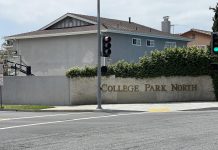
The somewhat obscure governmental agency whose mission it is to police land use near Orange County airports met Sept. 21 to determine, among other things, how to handle the city of Los Alamitos’ inability to overrule its finding that three of the potential homebuilding sites in their approval housing element were inconsistent with approved land use around an airport.
“Housing elements” are simply plans California municipalities must file with the state to identify potential future housing sites to construct a target number of new homes determined by the state or its designated agency.
During the debate over whether the city of Los Alamitos should, or should not overrule the Airport Land Use Commission (ALUC), several alternatives were suggested that would occur if the city failed to overrule a ruling that found three of the potential homebuilding sites in the city’s approved housing element were “inconsistent” with the standards of land use around an airport.
The Los Al City Council voted 3-2 to overrule ALUC, however, this is a rare vote that required four votes to pass, so it failed.
“On August 21, 2023, the City of Los Alamitos (City) held a public hearing to overrule the ALUC but a motion to do so failed.
As a result of the City’s failure to overrule, the ALUC may impose requirements on the City to submit all subsequent actions, regulations and permits to ALUC for consistency review until the City’s general plan is revised or the specific overrule findings are made,” wrote ALUC Executive Director Lea Choum to the other Commissioners.
In an executive office building next to John Wayne Airport, the group met last week to decide how to handle the city’s failure to overrule their findings of inconsistency.
Jeff Stock, Orange County Counsel to ALUC, told the commissioners they had three options.
The first option would have required the city to submit “discretionary actions that must be submitted: development agreements and amendments, administrative use permits, conditional use permits, site development permits, tentative and vesting parcel and tract maps, variances, and zoning consistency reviews. The submittal of the above discretionary actions does not excuse the City from continuing to separately submit all general plan amendments, specific plan amendments, zoning ordinance/map amendments to ALUC pursuant to the Public Utilities Code.”
Basically, said Stock, “Option 1 is for all of the main discretionary options while Option 2 deals with a much narrower scope that deals only with those three problematic sites.”
Option 2 will require the city to only submit items for the three affected areas that were found inconsistent in the housing element.
Option 2 reads “ALUC requires that the City submit the following discretionary actions, related to the three sites listed below, to the ALUC for a consistency review with the AELUP for JFTB, Los Alamitos, until the City’s general plan is either revised and re-submitted to ALUC for review or the City makes the requisite overrule findings related to its general plan.
Site 6 located at 4655 Lampson Avenue.
Site 7 Laurel Park APN 241-241-35.
Site 10 located at 5030-5084 Katella.”
Option 3 presented to the ALUC board was “to take no action at all.”
Almost immediately, the commissioners signaled they would prefer Option 2, which only requires the city to submit plans for the three areas found inconsistent to the housing plan.
Ron Noda, Development Services Director for the City of Los Alamitos, attended the hearing but did not speak to the ALUC board. “We are with the city of Los Alamitos but we will not be commenting, thank you,” Noda said to the ALUC commissioners.
Commissioner Alan Murphy said he preferred Option 2 because it “mostly affects the areas we are concerned about.”
Both he and Commissioner Schelly Sustarsic, who is a city Council member from Seal Beach, said Option 3, which was “taking no action,” was not acceptable to them.
Stock said under the scenario of Option 2, “the protocol would be similar to when a city would be submitting a general plan specific plan or zoning change to this commission. So there would be one of these items that would perhaps normally be either signed under some sort of delegated authority like a conditional use permit.”
“Perhaps it would also be something that the city would have otherwise taken to its planning commission or even a City Council for approval. Prior to receiving that approval. Whether it’s the district discretionary signing, planning commission or city council approval, it would need to be submitted to this commission for review,” said Stock.
“So staff would then take an initial look, it would create a staff report for those items and make recommendations similar to our normal course of business. And then this commission would ultimately decide whether or not those individual actions were consistent or inconsistent. And then the state would go back to the city in similar fashion where they can then move approval,” said Stock.
Asked about the timeframe, he suggested most it could be done within the mandated 60-day period allowed by law.”
The ENE has reached out to the City of Los Alamitos for comment but had not heard back as of press time.











